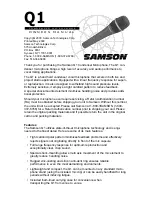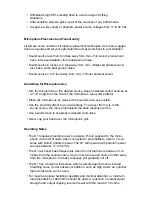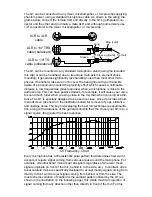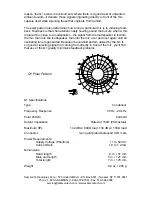
Every microphone has a characteristic polar pattern that determines how well it
accepts or rejects signal coming from various areas around the microphone. For
example, omnidirectional mics accept all signals regardless of wherever those
signals originate (in front of the mic, behind it, to the side, etc.). In contrast, direc-
tional cardioid mics are specifically designed to accept mostly signal coming from
directly in front, and to reject signal coming from behind or from the side. The
most extreme variation of cardioid is the cardioid pattern utilized by the Q1 (as
shown in the illustration on the following page); this yields maximum rejection of
signal coming from any direction other than directly in front of the mic. For this
The Q1 can be connected to any mixer, mixer/amplifier, or mic preamp supplying
phantom power, using a standard microphone cable. As shown in the wiring dia-
grams below, connect the female XLR end directly to the Q1’s gold-plated con-
nector and the other end (normally a male XLR end, although some mixers use
1/4" connectors) to the mixer, mixer/amplifier, or mic preamp.
1
2
3
1
2
3
1
2
3
1
2
3
Tip (hot)
Tip
Ring (cold)
Sleeve (ground)
Sleeve
Ring
XLR to XLR
cable
XLR to 1/4" TRS
cable (balanced)
XLR to 1/4" TS
cable (unbalanced)
The Q1 can be mounted to any standard microphone stand (using the included
mic clip) or can be handheld; due to its unique multi-axis mic element shock
mounting, it generates significantly less handling noise than most other micro-
phones. If handheld, take care not to cover the head grille with your hand. Be
aware of a phenomenon called the proximity effect which causes a noticeable
increase in low frequencies (bass response) when a microphone is close to the
audio source. This can have positive impact—for example, it will cause your voice
to sound much fuller when you sing close to the mic than when you sing at a dis-
tance. The Q1 is specially designed to be used up close, since it provides a built-
in windscreen (as shown in the illustration below) for removal of pops, sibilance
and onstage noise. The key to developing the best mic technique is experimenta-
tion, along with awareness of the general principle that, the closer your Q1 is to a
signal source, the greater the bass response.
Q1 Frequency Chart






















